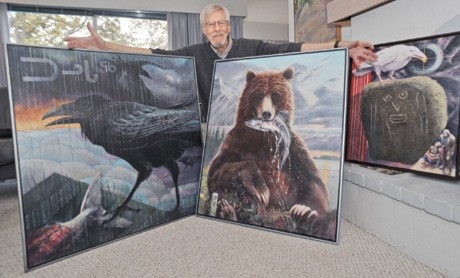“My people will sleep for 100 years, but when they awake, it will be the artists who give their spirit back.”
Louis Riel didn’t know it at the time, but he was talking about Frank Lewis.
Standing six-foot-six, with blue eyes and a full head of white hair, Lewis knows the hardship and joy of being Métis.
On Sept. 20, he presented an elaborate painting portraying that dichotomy to the Royal Jubilee Hospital Patient Care Centre, where it will hang in the All Nations Healing Room.
“This painting represents the culmination of a 65-year career,” Lewis told a crowd at the unveiling.
It is likely to be his last public work in a remarkable career that leaves a legacy across the country in multiple genres, from painting to acting to graphic design.
He graduated from Oak Bay High in 1952 and attended the Vancouver School of Art – now the Emily Carr University of Art and Design – on a scholarship before he moved to Toronto.
He quickly established himself as a skilled graphic designer at CBC television and in some of North America’s biggest advertising studios, winning numerous industry awards between 1957 and 1964.
In the underground music scene in Toronto and Montreal, he befriended the likes of Cannonball Adderley and Chico Hamilton, while designing album artwork and posters for many of the future legends of jazz.
“You could go to the Pilot Tavern (in Toronto), sit down, and for 35 cents a beer, watch Thelonius Monk playing on the stand,” Lewis said.
As the golden years of bebop faded, so too did Lewis’ drive to produce meaningful art.
“It was a lot of fun, but I wasn’t going anywhere,” he said.
He kept painting by undertaking a government-commissioned project to promote Canadian art.
“I painted a boxcar for the B.C. government. It was a silly idea,” he said, recalling his agent’s initial attempt to lobby the federal government on the idea of funding a travelling art train.
“We got a letter back from (then-prime minister Lester) Pearson that said, ‘No self-respecting artist would paint on a boxcar.’”
The B.C. government, led at the time by W.A.C. Bennett, jumped at the chance for publicity and commissioned Lewis after Pearson’s letter was picked up by the national media.
The “silly idea” toured North America for two years and was featured in the New York Times and Maclean’s Magazine, among others.
In 1967, Lewis earned a spot as a young Indian boy on the debut of George Ryga’s play, The Ecstacy of Rita Joe, at the Vancouver Playhouse.
Two years later, the play opened the studio theatre of the National Arts Centre in Ottawa, where Lewis mingled with the country’s elite and artists alike.
“I sat down with Chief Dan George, Jean Chrétien and Pierre Trudeau and talked about the Indian Act,” Lewis said, recalling nights out on the town with Trudeau.
“He took my girlfriend away,” he said, laughing.
In the mid 70s, Lewis landed in Cumberland, B.C., where he briefly worked as editorial cartoonist for the now-defunct Comox Free Press. He recalled cycling through town in the middle of the night to meet the paper’s 3 a.m. print deadlines.
It took a visit from an old Toronto friend in 1982 to reawaken Lewis to his ambitions.
“We had gone to the bar, and on the way home, there was a dog sleeping in the middle of the road,” he said. “So we lay down beside the dog and said, ‘Our careers have come to this.’ I had won the graphic designers award, illustrator of the year, and there we were, laying in the middle of the road with a dog.”
He began accepting commissions for murals, first illustrating Cumberland’s coal mining history on the inside of a local general store in exchange for a small stipend and free groceries.
He then completed a five-by-20-metre mural of the Gumboot Navy for the Vancouver Maritime Museum to much fanfare, solidifying his reputation as a world-class painter.
“I had newspaper headlines and I was thinking, ‘I don’t mind success, but why give me so much so quickly?’ It was really hard to deal with right away,” he said.
He met his current wife, Margaret Parker, at their 40th high school reunion in 1992.
“She was a high school sweetheart, and it was love at first sight,” he said.
Lewis has since produced 20 major public artworks, including the Burnside Gorge Community Mural on the Galloping Goose Trail in 2006.
He and Parker have travelled the world. In Kuala Lumpur, Malaysia, Lewis completed a mural for the boardroom of the Canadian High Commission, while Parker helped develop an architectural and art school.
They now live in Saanich, their home filled with Lewis’ dearest work. His blue eyes light up as he recalls all that connects him with his Métis heritage.
“We’re everywhere, but not together,” he said. “That spirituality is still in me, and has been all through my career.”
dpalmer@vicnews.com
